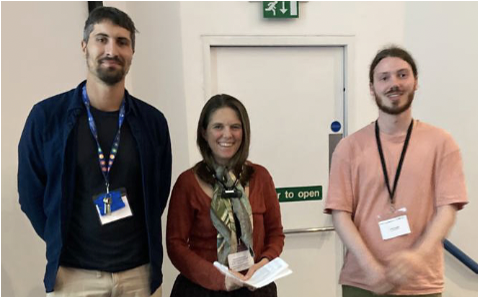Lewis Grant wins best student talk at UK- International Ocean Discovery Program Conference 2023

Over the summer, Lewis Grant, PhD student in the School of Ocean and Earth Science, University of Southampton, presented his work developing a semi-automated classification model for drill core images at the UK International Ocean Discovery Program Conference. For this he won the best student talk prize. Lewis shares more shares more about his work and its implications below.
“Back in 2017 I attended my first UK International Ocean Discovery Program (UK-IODP) annual conference as a Master’s student, presenting a poster on nanofossils from sediments cores collected from the palaeoequatorial Pacific. Since then, I have been captivated by the variety of science that takes place under the multidisciplinary umbrella of the IODP. After several years working in academic publishing, I returned to academia to do a PhD studying the chemical exchanges that occur between the ocean crust and seawater through time, under the supervision of Dr. Rosalind Coggon, Prof. Damon Teagle, and Prof. Blair Thornton (University of Southampton). The project is fully funded by the Royal Society and involves novel approaches that combine traditional geochemical analyses with modern computational methods to improve calculations of the fluxes of elements between the earth and ocean.
The focus of my project has been to modify machine learning algorithms designed to improve the descriptive accuracy of neural networks when used to classify seafloor imagery for use on images of geological drill core. My approach has been to test several state-of-the-art methods that learn from a large dataset of images and extract information about the images in an unsupervised manner (i.e., with no human labelling effort of training images required). Traditionally, unsupervised approaches tend to be less accurate than supervised methods that train a neural network with a dataset of expert-labelled images and require a lot more human effort. We have demonstrated that modifying unsupervised learning frameworks to utilize spatial metadata accompanying an image of a drill core, such as depth and width on the core surface, significantly improves model accuracy to > 90 %. The result is a semi-automated workflow that uses both an unsupervised neural network and a small subset of human labelled training images to classify images of drill core with greater accuracy than supervised networks for the same human effort.
I presented these results at the 2023 UK-IODP conference held in July at the National Oceanography Centre in Southampton and received a prize for the best student talk sponsored by the Geological Society of London (GSL). This was a great opportunity to share these exciting findings and the feedback given by the judges was both constructive and encouraging. I would like to thank both the UK-IODP and Geochemistry and Marine Studies Groups of the GSL for the award.”